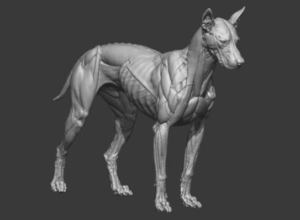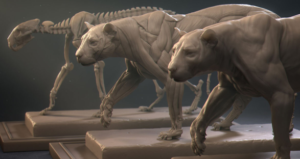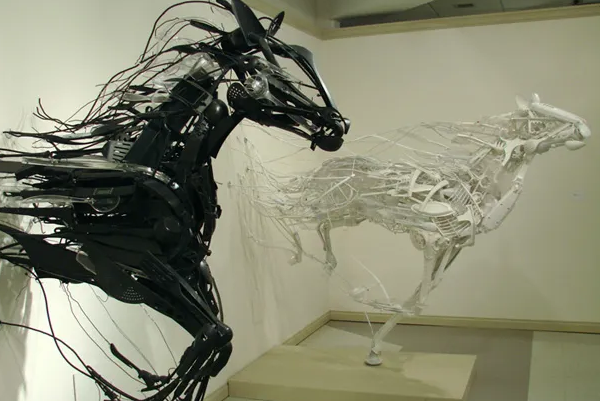Table Of Contents
- 1 Session 1: Capturing Nature’s Essence: Sculpting Animals from Real Life References
- 1.1 Why Sculpt from Real Life?
- 1.2 Session 2: Unpacking the Toolbox: Exploring Real-Life References for Animal Sculptors
- 1.3 1. The Living Canvas: Observing Animals in Action:
- 1.4 2. Capturing the Moment: Photography as a Reference Tool:
- 1.5 3. Unveiling the Inner Workings: Anatomy Resources for Animal Sculptors:
- 1.6 4. Beyond the Surface: Combining References for Expressive Sculptures:
- 1.7 5. Artistic Inspiration: Drawing from the Masters:
- 1.8 Session 3: Translating Inspiration into Creation: Using Real-Life References in Your Sculpting Workflow
- 1.9 1. Defining Your Subject and Goals:
- 1.10 2. Gathering Your Reference Arsenal:
- 1.11 3. Observation and Analysis:
- 1.12 4. Translating Reference into Form:
- 1.13 5. Refining and Adding Life:
- 1.14 6. Documentation and Reflection:
- 1.15 Session 4: Bringing Your Artistic Journey to Life: FAQs and Resources for Sculpting Animals from Real-Life References
- 1.16 FAQs:
- 1.17 Q: What are some challenges beginners face when using real-life references?
- 1.18 Q: How can I ensure my sculptures are anatomically accurate?
- 1.19 Q: What are some tips for capturing the personality and expression of my animal subject?
- 1.20 Q: Where can I find additional inspiration and learning materials for animal sculpture?
Session 1: Capturing Nature’s Essence: Sculpting Animals from Real Life References
Have you ever been captivated by the intricate beauty and majestic presence of an animal? Have you ever wished to capture that essence, not just in a photograph or fleeting memory, but in a tangible, three-dimensional form? If so, then the captivating world of sculpting animals from real-life references is calling out to you.
This introductory session will guide you through the awe-inspiring journey of animal sculpture, highlighting the significance of using real-life references as your guiding light. We will delve into the benefits, methods, and resources available to help you bring your animal visions to life with stunning accuracy and expressiveness.
Why Sculpt from Real Life?
Observing and interacting with animals in their natural environment offers a wealth of information and inspiration that simply cannot be replicated by relying solely on imagination. By utilizing real-life references, you gain access to crucial insights that elevate your sculptures to a whole new level:
- Enhanced Accuracy: Real-life observations allow you to meticulously study an animal’s anatomy, proportions, and movement patterns, ensuring your sculptures are anatomically correct and lifelike.
- Unveiling Hidden Details: Nature’s intricate details often go unnoticed until you immerse yourself in observing a living creature. From subtle fur textures to the glint in their eyes, real-life references reveal these hidden gems, enriching your sculptures with authenticity.
- Capturing Individuality: No two animals are exactly alike, and capturing their unique spirit is what separates a good sculpture from a great one. Observing individual animals reveals their personalities, expressions, and quirks, allowing you to breathe life and individuality into your creations.
- Fueling Creativity: Real-life encounters with animals can spark new ideas and ignite your creative spirit. Witnessing their grace, strength, and diverse behaviors can inspire you to push artistic boundaries and create truly innovative sculptures.
In the next session, we’ll explore the diverse types of real-life references available to animal sculptors, providing you with a comprehensive toolkit to embark on your artistic journey.

Session 2: Unpacking the Toolbox: Exploring Real-Life References for Animal Sculptors
Having grasped the immense value of utilizing real-life references in animal sculpture, we now delve deeper to explore the diverse toolbox available to fuel your artistic endeavors. Each type of reference offers unique benefits and caters to different learning styles and artistic approaches.
1. The Living Canvas: Observing Animals in Action:
- Live Animal Encounters: Witnessing animals in their natural habitat offers an unparalleled opportunity to observe anatomy in motion, capture fleeting expressions, and gain a deeper understanding of their behavior. Zoos, sanctuaries, and wildlife reserves can provide safe and controlled environments for observation.
- Sketching from Life: Capture the essence of movement and expression through quick sketches. This allows for rapid capture of fleeting moments and refines your observational skills.
2. Capturing the Moment: Photography as a Reference Tool:
- High-Quality Photographs: Professional wildlife photography captures stunning details and offers a wealth of reference material. Look for images that showcase diverse angles, poses, and lighting conditions for a comprehensive understanding of your subject.
- Personal Photography: Capture your own photographs of animals you encounter. This allows you to focus on specific details that resonate with you and personalize your approach to reference material.
3. Unveiling the Inner Workings: Anatomy Resources for Animal Sculptors:
- Anatomy Books and Online Resources: Delving into detailed animal anatomy resources provides valuable insights into skeletal structures, muscle groups, and internal organs. This knowledge is crucial for creating anatomically accurate and believable sculptures.
- Museums and Educational Institutions: Many museums and institutions boast extensive collections of animal skeletons and taxidermized specimens. These resources offer a firsthand look at bone structure, fur patterns, and the intricate details of animal anatomy.
4. Beyond the Surface: Combining References for Expressive Sculptures:
- Utilizing Multiple Reference Types: Combining various reference types, such as live observations, photographs, and anatomical resources, provides a well-rounded understanding of your subject. This allows you to create sculptures that are not only accurate but also expressive and infused with personal interpretation.
5. Artistic Inspiration: Drawing from the Masters:
- Studying Sculptural Masterpieces: Explore the works of renowned animal sculptors and learn from their techniques, approaches to anatomy, and interpretation of animal forms.
- Contemporary Animal Sculpture: Delve into the contemporary art scene and discover the diverse styles and approaches of modern animal sculptors. This can spark new ideas and inspire innovative interpretations of your chosen subject.
Equipped with this comprehensive toolbox of real-life references, you are now ready to embark on the exciting journey of sculpting animals with accuracy, expressiveness, and artistic flair. In the next session, we will delve into the practical aspect of using real-life references, guiding you through the process of incorporating them into your sculpting workflow.

Session 3: Translating Inspiration into Creation: Using Real-Life References in Your Sculpting Workflow
Having explored the diverse types of real-life references available, we now dive into the practical application of this invaluable resource. This session will equip you with the knowledge and strategies to effectively integrate real-life references into your sculpting workflow, empowering you to create stunning and lifelike animal sculptures.
1. Defining Your Subject and Goals:
- Choose Your Animal: Select an animal that resonates with you, piques your artistic curiosity, and challenges your skills.
- Set Clear Goals: Determine what you want to achieve with your sculpture. Do you aim for anatomical accuracy, expressive interpretation, or a combination of both?
2. Gathering Your Reference Arsenal:
- Collect Diverse References: Utilize a variety of reference types discussed in the previous session to gain a comprehensive understanding of your chosen animal.
- Organize and Catalog: Label and categorize your references for easy access and efficient workflow.
3. Observation and Analysis:
- Actively Observe: Go beyond simply looking. Pay close attention to details, proportions, and movement patterns. Analyze the underlying anatomy and the subtle nuances that define your subject.
- Sketching and Note-taking: Capture your observations through sketches and detailed notes. This helps process information and retain key elements for later reference.
4. Translating Reference into Form:
- Utilize Reference Images: Project or transfer reference images onto your sculpting surface to guide your initial form building and ensure accurate proportions.
- Anatomical Landmarks: Mark key anatomical landmarks on your armature based on your reference materials to ensure proper placement of muscles and features.
- Sculpting with Attention to Detail: As you sculpt, continuously refer to your gathered resources to ensure anatomical accuracy and capture the unique details that bring your subject to life.
5. Refining and Adding Life:
- Compare and Contrast: Regularly compare your work with your references to identify areas needing improvement and ensure consistency with your chosen animal.
- Infusing Expression: Go beyond mere representation and imbue your sculpture with personality and expression. Capture the essence of your animal through subtle details and nuanced sculpting techniques.
- Adding Texture and Color: Utilize texture tools and paints to replicate your animal’s fur texture, skin tones, and other unique markings, further enhancing the realism and visual impact of your sculpture.
6. Documentation and Reflection:
- Document Your Process: Take photographs and keep detailed notes throughout your sculpting journey. This allows you to track your progress, learn from mistakes, and analyze your artistic development.
- Reflect on Your Work: Take time to critically evaluate your finished sculpture. Identify areas of success and areas for improvement, allowing you to refine your skills and approach with each new project.
By incorporating these practical strategies for using real-life references, you can transform your animal sculptures from anatomical studies to captivating art pieces brimming with life and personality. In the final session, we will address frequently asked questions and provide additional resources to empower your continued exploration of the world of sculpting animals from real-life references.
Session 4: Bringing Your Artistic Journey to Life: FAQs and Resources for Sculpting Animals from Real-Life References
Having traversed the captivating journey of sculpting animals from real-life references, this final session aims to further empower your artistic development by addressing frequently asked questions and providing valuable resources to nurture your passion for animal sculpture.
FAQs:
Q: What are some challenges beginners face when using real-life references?
A: Common challenges include:
- Maintaining focus: Observing animals can be mesmerizing. Set time limits for observation and focus on specific details to maximize your learning.
- Translating details from reference to sculpture: Accurately capturing subtle details and nuances requires practice and patience. Start with simple forms and gradually progress to more complex details.
- Finding the right balance between accuracy and artistic interpretation: Striking a balance between capturing the essence of your subject and injecting your own artistic vision requires experimentation and self-evaluation.
Q: How can I ensure my sculptures are anatomically accurate?
A: Thoroughly study animal anatomy resources, utilize reference images from multiple angles, and compare your work with your references throughout the sculpting process. Additionally, attending anatomy workshops or seeking feedback from experienced sculptors can be invaluable.
Q: What are some tips for capturing the personality and expression of my animal subject?
A: Observe your animal’s behavior and expressions in their natural environment. Study animal communication and body language to understand how they convey emotions. Focus on sculpting subtle details like eye shape, posture, and facial expressions to breathe life into your creation.
Q: Where can I find additional inspiration and learning materials for animal sculpture?
A: Explore the following resources to expand your knowledge and artistic repertoire:
- Online tutorials and courses: Platforms like Skills are, Udemy, and YouTube offer diverse courses and tutorials for various animal sculpting techniques and anatomical studies.
- Art communities and forums: Connect with other animal sculpture enthusiasts online to share your work, ask questions, and receive valuable feedback.
- Museums and art galleries: Visit exhibitions featuring animal sculptures to gain inspiration from established artists and explore diverse styles and techniques.
- Books and magazines: Discover books and magazines dedicated to animal sculpture, featuring techniques, projects, and artist profiles.
Remember, the journey of sculpting animals from real-life references is a continuous process fueled by passion, dedication, and a willingness to learn. Embrace the challenges, celebrate your successes, and never stop exploring the possibilities this art form offers. With the resources provided and a commitment to your artistic development, you can create stunning and impactful animal sculptures that capture the essence of life in all its beauty and complexity.

1 thought on “Sculpting Animals From Real Life References”